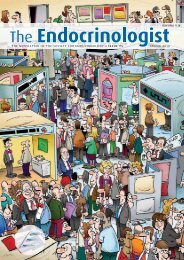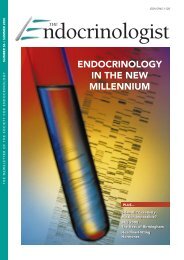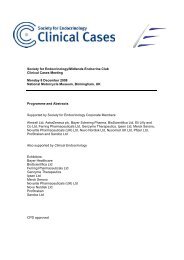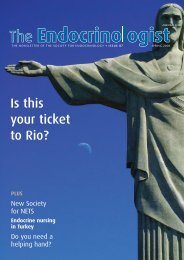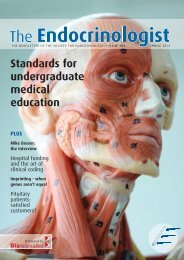The Endocrinologist | Issue 93 - Society for Endocrinology
The Endocrinologist | Issue 93 - Society for Endocrinology
The Endocrinologist | Issue 93 - Society for Endocrinology
Create successful ePaper yourself
Turn your PDF publications into a flip-book with our unique Google optimized e-Paper software.
Paying fees <strong>for</strong> open access publishing:towards a strategic responseHave you had difficulty in getting hold of fundingto make your paper open access? Although manyfunders, and indeed now even some institutions,insist that you make your published paper free to allwithin a short deadline, it’s not always clear how youare to pay the ‘author-side’ fees needed to makefree-to-view publication viable. Universities UK haspublished a report to tackle this important question.Some mandating bodies have not made theconnection that their mandates have funding implications,perhaps imagining that making copies of articles freelyavailable on open repositories has no repercussions <strong>for</strong> thejournals upon which they depend. <strong>The</strong>re are others whichhave clearly budgeted to provide these funds but, eventhen, it is not always clear to authors how they can gethold of them via their institutions. Only a very smallnumber of UK higher education institutions currently haveany clear arrangements in place.UUK’s report, published jointly with the ResearchIn<strong>for</strong>mation Network, seeks to address these concernsby setting out guidelines <strong>for</strong> the key stakeholders. <strong>The</strong><strong>Society</strong>’s staff (Sue Thorn and Steve By<strong>for</strong>d) were activeparticipants in drawing up the report. <strong>The</strong> BiosciencesFederation has also endorsed it.<strong>The</strong> report recommends the following:• HEIs should each set up a dedicated budget to payauthor-side open access publication charges.• Funding bodies should clarify how they will providesupport <strong>for</strong> researchers to meet their open accesspolicies, especially regarding the payment of openaccess fees.It also suggests that authors should make use ofresources such as the Biosciences Federation’s Authors’Guide to UK funders’ policies on Open Access, andfamiliarise themselves with their funder’s policies and thearrangements within their institution. Publishers areasked to give clear advice to authors on their open accessrequirements and on the associated fees.If the report’s recommendations are followed, it willrepresent an important step towards a joined-up approachto open access, and help remove the corrosive effects ofunfunded mandates.STEVE BYFORDFURTHER READINGPaying <strong>for</strong> open access publication charges (Report of Universities UKand the Research In<strong>for</strong>mation Network) www.rin.ac.uk/openaccesspayment-feesAuthors' Guide to UK funders' policies on Open Access (BiosciencesFederation) www.bsf.ac.uk/journals/journals_authors'guide.htm<strong>Society</strong> <strong>for</strong> <strong>Endocrinology</strong> policy on self archiving on institutional andother repositories www.endocrinology-journals.org/misc/archiving_policy.dtlNew Chair <strong>for</strong> BBSRC<strong>The</strong> <strong>for</strong>mal appointment of Professor Sir Tom BlundellFRS FMedSci as the new Chair of the Biotechnology andBiological Sciences Research Council (BBSRC) wasannounced on 18 June 2009 by the Department <strong>for</strong>Business, Innovation and Skills.Results: SCE in <strong>Endocrinology</strong>and DiabetesA total of 39 candidates sat the first diet of the SpecialtyCertificate Examination in <strong>Endocrinology</strong> and Diabetes inMay 2009. <strong>The</strong> overall pass rate was 38.5% with 64.3% ofthe UK trainees passing the examination. For furtherin<strong>for</strong>mation visit www.mrcpuk.org/SCE/Pages/Results.aspx.Ox<strong>for</strong>d Handbook of<strong>Endocrinology</strong> and DiabetesSecond edition20 % discount<strong>for</strong> SFE membersOx<strong>for</strong>d Textbook of <strong>Endocrinology</strong> andDiabetes<strong>Society</strong> <strong>for</strong> <strong>Endocrinology</strong> T H E E N D O C R I N O L O G I S T • I S S U E 9 3 • A U T U M N 2 0 0 95
and innate/adaptive immune interface in the pathogenesisof type 1 diabetes. Her work in animal models is carried out inparallel with translational development of immunotherapy<strong>for</strong> type 1 in collaboration with Colin Dayan.Rob Andrews, a senior lecturer in our department, hasdeveloped one of the country’s largest medical obesityclinics at Musgrove Park Hospital in Taunton. Last year sawover 1400 referrals and more than 400 surgical procedures.<strong>The</strong>y have now been made lead centre in the south-west asan international centre of excellence <strong>for</strong> bariatric surgery.This programme importantly has a large research portfoliolooking at the effect of weight loss and surgery on guthormones and insulin secretion, signalling and sensitivity.We have been <strong>for</strong>tunate in the appointment of KarinBradley as full-time NHS consultant endocrinologist. Witha DPhil in molecular endocrinology from the University ofOx<strong>for</strong>d and extensive clinical experience, she has helpedto optimise care <strong>for</strong> patients with multiple endocrineneoplasia and other rare genetic endocrine syndromes.She has developed a regular monthly neuroendocrinetumour multidisciplinary team at the BRI, which attractsreferrals from across the south-west of England.Karin is also the endocrinology representative on thesteering group investigating service delivery <strong>for</strong> ‘lateeffects’ patients living in the Peninsula region, and ishelping to establish a co-ordinated local clinical service<strong>for</strong> these survivors of childhood cancer. Her interests androles include endocrinology in a critical care setting andendocrine disorders during pregnancy, as well as diabetescare and general medicine. She has recently been joinedby a second NHS colleague, Bushra Ahmad.<strong>The</strong> University Hospitals Bristol NHS Foundation Trust(UHBT) also has an extremely active paediatric endocrineprogramme. It has one of the UK’s largest obesityservices, run by Julian Hamilton-Shield, and one of theUK’s largest paediatric diabetes services, with anemphasis on research into rare <strong>for</strong>ms of diabetes,neonatal diabetes, Down’s syndrome and autoimmunity.Julian in particular has been the driving <strong>for</strong>ce behindthe discovery of 6q imprinting anomalies in neonataldiabetes, KCNJ11 mutations causing neonatal diabetes andthe discovery of genes involved in neonatal glucosemetabolism, PTFA1, ABCC8, HNF4 alpha and GLUD1mutations and the cause of neonatal hyperinsulinaemia.Collaborative studies with Jeff Holly have focused on insulinresistance in obesity, including studies on adipocytes withrespect to adipogenesis and insulin resistance. Liz Crowne isChair of the British <strong>Society</strong> <strong>for</strong> Paediatric <strong>Endocrinology</strong> andDiabetes, and her research has concentrated on the lateeffects of cancer treatment on endocrine systems.Reproductive endocrinology is led by David Cahill andAndrés López Bernal. David’s focus is on the endocrinestatus of serum and follicular fluid and its relationshipwith successful in vitro fertilisation. His data suggestdifferential regulation in patients with minor degrees ofendometriosis. Andrés concentrates on CRH and oxytocinsignalling in the normal and pregnant myometrium andthe abnormalities that occur in premature labour.In north Bristol, Edwin Gale and Polly Bingley lead amajor diabetes research centre. <strong>The</strong>y have developed thecurrent model <strong>for</strong> predicting future onset of diabetes inclose relatives of an affected child. This led on to ENDIT(1994-2003), a multinational intervention trial. <strong>The</strong>irinterest in the epidemiology of type 1 diabetes has led toa close collaboration with Kathleen Gillespie, studyingthe role of NK cells in autoimmune diabetes andimmunogenetic characterisation of diabetes in Down’ssyndrome. Edwin played a prominent role in the earlystages of the EURODIAB ACE network which has greatlyclarified trends in the epidemiology of childhood-onsetdiabetes in Europe. He is Editor of Diabetologia.Jon Tobias works on metabolicbone disease, with a particularinterest in the pathogenesis andmanagement of osteoporosis.Through the unique ‘Children of thenineties’ birth cohort, we are gainingimportant insights into the factorswhich affect skeletal development inchildhood, such as maternal vitaminD exposure, fat mass, and a varietyof genetic influences. Jon helps leada nationwide study characterising thephenotype and genotype ofindividuals with extremely high bonemass, which has provided furtherevidence of an important linkbetween obesity and bone metabolism. Through theCOSHIBA study, he is examining whether a new clinicaltool can identify patients with undiagnosed vertebralfractures. He has a strong local interest in steroid-inducedosteoporosis, exemplified by randomised controlled trialsexamining the role of bisphosphonates in preventingbone changes following steroid therapy <strong>for</strong> inflammatorybowel disease and multiple sclerosis.Jeff Holly was one of the first scientists to realise theimportance of IGFs and he has been an active leader inthe International <strong>Society</strong> <strong>for</strong> IGF Research. He played amajor role in working out the inter-relationship of GH,IGF-1 and their metabolic effects, and now works closelywith epidemiologists at the Department of SocialMedicine in Bristol, studying a variety of large populationcohorts to examine how metabolic and hormonal statusrelate to the development and progression of chronicdiseases, particularly the hormone-dependent cancers.Overall, there is a wealth of clinical and basic scientificexpertise and activity in Bristol. With the proposed mergerof the UBHT and the North Bristol NHS Trust, we expecteven greater integration of research activities. We anticipateconsiderable development of the translational studies in theneuroendocrine and metabolic areas, and the synergies ofthe numerous research groups and our colleagues inCardiff and the Peninsula will ensure Bristol remains a majorhub of novel research and endocrine clinical development.Please visit our websites(www.bristol.ac.uk/clinicalsciencesouth/hwline,www.bris.ac.uk/clinicalsciencesouth,www.bris.ac.uk/clinicalsciencenorth,www.uhbristol.nhs.uk, www.nbt.nhs.uk),and if anyone is interested in discussingresearch activities with us, then youare of course very welcome.STAFFORD LIGHTMANDorothyHodgkinBuildingT H E E N D O C R I N O L O G I S T • I S S U E 9 3 • A U T U M N 2 0 0 97
Standing up<strong>for</strong> scienceEmma Rossfound aVoice <strong>for</strong> YoungScience at arecent mediaworkshop - andsuggests youdo the same.<strong>The</strong>re is huge public appetite <strong>for</strong> finding out aboutthe latest scientific discoveries and how they mightaffect how we live our lives. But all too often thisscience becomes sensationalised or misrepresented inthe media, which can, at very least, misin<strong>for</strong>m or givefalse hope and, at worst, damage attitudes towardsthe medical profession and cultivate the use ofunproven, sometimes dangerous, alternatives.Sense About Science is a charity which works withscientists to promote good science and evidence <strong>for</strong>the public, and their Voice of Young Science (VoYS)programme aims to help early career researchersstand up <strong>for</strong> science in the public domain (seewww.senseaboutscience.org/VoYS).VoYS held another of their successful mediaworkshops last June in London. <strong>The</strong>se workshops aim togive early career researchers an insight into andunderstanding of how science is portrayed andcommunicated in the media, and what they can do toget involved and prevent misrepresentation.<strong>The</strong> workshop opened with a sessionon the role of science and scientists inthe public domain, and what happenswhen facts are distorted or discussionsbecome polarised. <strong>The</strong> media-savvypanel gave the audience an excellentinsight into how to work successfullywith the media.Dr Robin Lovell-Badge, Head of the Division ofDevelopmental Genetics at the MRC, relayed hisexperiences of the media coverage of his work into sexdetermination in mice (cue lots of humorous tabloidheadlines) and stem cell research. His scientific expertisein such topical issues has led to him be frequently calledinto news studios as their ‘expert scientist’. Heemphasised that in these situations you have very littletime to get your key message across, and can easily getled off track by the journalist. His advice was to identifytwo or three key points that you want to get across, andmake that your sole aim of the interview. If the questionsdon’t fit those key messages, ‘bridge’ to make them fit.Catherine Collins, Chief Dietician at St George’sHospital, talked about the challenges of dealing withpseudoscience communicated by unqualified individuals.Although ‘dietician’ is a protected title, anyone can be a‘nutritionist’, and Catherine highlighted how celebritiesand laymen alike have jumped on this bandwagon andnow give what is portrayed as ‘scientific’ advice, which israrely evidence-based. She emphasised the importance ofchallenging the scientific credentials of such people, orsuch claims, and recommended using blogs and internet<strong>for</strong>ums to get your side of the story across.Professor Mark Enright, Professor of MolecularEpidemiology at Imperial College London, has also hadhis fair share of media exposure, particularly in relation tothe MRSA stories. His message was that if you work withthe media you can use them to your advantage, but tobe aware of their tendency to extrapolate unrealistically:the functional consequences <strong>for</strong> humans of results from alab bench are often predicted too quickly.<strong>The</strong> next session comprised a well-balanced panel ofjournalists from <strong>The</strong> Sun, BBC and Nature. All raised theissue of the strict deadlines that are imposed, whichreduce the time available <strong>for</strong> fact-checking andcontacting the key scientists involved in the research.Whilst the panel all had strong science backgrounds, thisis not always the case, and it was evident that journalistsare at the ‘mercy’ of their subeditors, who often don’thave much experience of science.<strong>The</strong> panel also emphasised their need to make a storyentertaining and engaging <strong>for</strong> the public, which ofteninvolves simplifying facts, or allowing the story to be‘sexed up’ a little! <strong>The</strong>ir advice was to ensure you have areally good press release, as this is will be the source ofmost in<strong>for</strong>mation <strong>for</strong> their article. This means keeping itsimple and understandable, and being explicit aboutwhy this science is novel or unique.<strong>The</strong> day was rounded off by a Sense About Sciencepanel talking about the opportunities <strong>for</strong> early careerresearchers to get their voices heard in debates aboutscience, and how to respond to bad science when yousee it. In addition, Lucy Goodchild, from the ImperialCollege Press Office, spoke enthusiastically about gettingto know your press officer, and letting them help youdisseminate your research findings to a wider audience.<strong>The</strong> main message from this panel was that there are notenough young, enthusiastic, early career scientistsgetting involved with the media, yet these are exactlythe sorts of people the media would love to haverepresenting science. So, go <strong>for</strong> it!I found the workshop very helpful as it gave me anall-round perspective of science and the media, from thescientists who have extensive experience of their workbeing disseminated into the public arena, to thejournalist whose job it is to convey it responsibly, via thepress officers who can make the difference between agood and bad media experience.I would recommend the VoYS media workshops to anyearly career researchers who either find their own workattracting media interest or simply have an interest inresponsible dissemination of science in the media today.EMMA ROSSTo find out more about VoYS workshops and projects,contact Julia Wilson at voys@senseaboutscience.org or seewww.senseaboutscience.org. <strong>The</strong> next ‘Standing up <strong>for</strong> Science’media workshop takes place in Edinburgh on 6 November.8 T H E E N D O C R I N O L O G I S T • I S S U E 9 3 • A U T U M N 2 0 0 9
Grants and awards 2009Welcome to this special section on the <strong>Society</strong>’s grant and award activities. As many of you know, the <strong>Society</strong>has been able to increase the budget <strong>for</strong> these activities considerably. <strong>The</strong>y include Early Career Grants(previously termed Small Grants), Summer Studentships and support <strong>for</strong> conferences, laboratory and clinicaldepartment visits.Following the success of our grant and award schemes, we have launched this annual update of the awards madeduring the year, reports from some of the recipients, and just some of the positive feedback we have received from<strong>Society</strong> events.Thank you <strong>for</strong> all the comments you have supplied via <strong>for</strong>ms and email in the past year. It really helps us mould ourmeetings better and match awards to members’ needs.For in<strong>for</strong>mation about all the <strong>Society</strong>’s grants see the website at www.endocrinology.org/grants. <strong>The</strong> next deadline<strong>for</strong> the Early Careers Grant will be 27 November 2009.ALAN MCNEILLY, GRANTS PANEL CHAIR, SCIENCE COMMITTEE CHAIRReports on the Patient Support Grants will be published in the next issue.AWARD WINNERSEarly Career Grants(<strong>for</strong>merly Small Grant Programme)We congratulate the following successful recipients ofawards made under the Early Career Grant programmeafter the May 2009 deadline:• Lesia Kurlak (Professional Unit of Obstetrics andGynaecology, University of Nottingham), awarded£9621 <strong>for</strong> ‘Placental selenoproteins’ iodothyroninedeiodinases expression and activity in normal andpreeclamptic pregnancies’• Laura Matthews (Department of Medicine, Universityof Manchester), awarded £9680 <strong>for</strong> ‘Investigating Gcsensitivity in meiosis’• Nicole Reisch (School of Clinical and ExperimentalMedicine, University of Birmingham) awarded £10 000<strong>for</strong> ‘Analysing protein degradation of 21-hydroxylaseas a novel approach towards an improvedunderstanding of the molecular pathogenesisof congenital adrenal hyperplasia’• Kirsty Smith (Department of Investigative Medicine,Imperial College London) awarded £6621 <strong>for</strong>‘Augurin, a novel regulator of the hypothalamopituitary-adrenalaxis’• Emily Thompson (Department of InvestigativeMedicine, Imperial College London) awarded £9814<strong>for</strong> ‘Do inherent differences in leptin sensitivitypredict age of pubertal onset and propensity tobecome obese?’Summer Studentship Winners 2009<strong>The</strong> following departmental applications were acceptedand awarded grants in May 2009:• Institute of Biomedical Research,University of Birmingham• Queen’s Medical Research Institute,University of Edinburgh• Laboratory of Molecular Signalling,Babraham Institute, Cambridge• School of Clinical and Experimental Medicine,University of Birmingham• University of Algarve, Faro, PortugalUndergraduate AchievementAward 2009<strong>The</strong>se awards are to encourage excellence in the study ofendocrinology by undergraduate students by providing a3 year grant <strong>for</strong> departments to use as they see fit torecognise outstanding undergraduates.<strong>The</strong> following each received an award <strong>for</strong> £300 perannum <strong>for</strong> 3 years, following the 17 July 2009 deadline:• Department of Physiology, Anatomy and Genetics,University of Ox<strong>for</strong>d• School of Life Sciences, Kingston University, LondonOverseas conference grantsDecember 2008 deadline: 129 awarded, 9 declinedApril 2009 deadline: 57 awarded, 8 declinedPostgraduate Essay PrizeCompetition<strong>The</strong> <strong>Society</strong>’s new essay competition was launched earlier this year.Made available to members and non-members alike, it is open to allstudents registered <strong>for</strong> a higher degree in the UK or Ireland at the timeof essay submission (e.g. a Masters course or research degree such asMPhil/PhD/MDRes or equivalent). Full details can be found atwww.endocrinology.org/grants/prize_postgraduateessay.html. <strong>The</strong> winnerof this year’s competition will be announced in a subsequent issue.CORPORATE SPONSORSWe take this opportunity to thank allour corporate sponsors <strong>for</strong> theirgenerous support, which enables the<strong>Society</strong> to offer many of their grants tofund endocrinologists at all stages oftheir careers. For more in<strong>for</strong>mationabout the <strong>Society</strong>’s corporate sponsors,see www.endocrinology.org/corporate.T H E E N D O C R I N O L O G I S T • I S S U E 9 3 • A U T U M N 2 0 0 99
GRANT REPORTSLab Visit Grant Report 2009:11βHSD1 and glucocorticoidproduction in adipose tissueMy clinical and laboratory studies focus on theenzyme 11β-hydroxysteroid dehydrogenase type 1(11βHSD1) and its contribution to glucocorticoidproduction in adipose tissue. This grant enabled meto spend a period of time at the Ox<strong>for</strong>d Centre <strong>for</strong>Diabetes, <strong>Endocrinology</strong> and Metabolism (OCDEM),where I worked under the supervision of Dr FredrikKarpe. <strong>The</strong> purpose of my study was to measure11βHSD1 directionality across human subcutaneousadipose tissue in vivo.Over the past 2 years of my PhD in Edinburgh, I havedeveloped and validated a new method to measureglucocorticoid inactivation in vivo using a stable isotopetracer (d2-cortisone). <strong>The</strong> aim was to use this new stableisotope tracer along with an established cortisol tracer(d4-cortisol) to measure and compare glucocorticoid(cortisol and cortisone) generation across two metabolicallyimportant tissues, subcutaneous abdominal adipose tissueand muscle. In addition, we aimed to assess the effects ofhyperinsulinaemia on enzyme activity and directionality.Arterio-venous (AV) sampling across adipose tissueallows the measurement of abdominal adiposeglucocorticoid production. This technique was developedby Keith Frayn and colleagues in Ox<strong>for</strong>d. So, the purposeof my visit was to learn this technique and apply the newtracer method I had developed, to better understandglucocorticoid generation in these tissues.This project also provided me with the opportunityto learn other clinical research techniques, e.g. adiposebiopsies, that I will be using in future studies in Edinburgh.Although the plasma samples and blood flow datafrom this study are not yet processed, I hope that theresults from this project will lead to published papers andpresentations at local and national scientific meetings.Furthermore, in<strong>for</strong>mation from this study on theregulation and activity of adipose 11βHSD1 will provideclinically relevant in<strong>for</strong>mation <strong>for</strong> the 11βHSD1 inhibitordrug-development programmes.I am grateful to the <strong>Society</strong> <strong>for</strong> <strong>Endocrinology</strong> <strong>for</strong> theLab Visit Grant towards this project, allowing this firstsubstantive collaboration at both sites. I am also gratefulto the staff and volunteers in Ox<strong>for</strong>d <strong>for</strong> their invaluablehelp with this study.KATHERINE HUGHES‘A very inspiring conference academically<strong>for</strong> a junior trainee like myself’‘This meeting was, as usual, superb. Good mix of basicand clinical science. Plenary sessions were of both clinicaland scientific interest/relevance’‘All excellent plenaries. Provided a nice mix of science andclinical endocrinology which was stimulating and useful’comments from recipients of <strong>Society</strong> BES 2009 travel grantsSponsored Seminar Grant 2008:Integrated mechanisms of cellularidentity and homeostasis<strong>The</strong> Babraham Institute in Cambridge celebrated60 years of science with an International DiamondJubilee conference on 26 and 27 June 2008. <strong>The</strong>programme comprised top international speakers,including several <strong>for</strong>mer Babraham Institute scientists(Azim Surani, Robert Feil, Nullin Divecha, BrigittaStockinger and Steve Jameson).Research interests at Babraham have clearly evolvedconsiderably over the past 60 years. <strong>The</strong> study ofendocrinology has been a key feature of the Institute’sremit, and the themes of the conference reflected themain areas that have led from this - signalling,development and immunology. <strong>The</strong> event broughttogether international leading researchers in epigeneticsand signalling to explore two convergent themesembracing these topics: epigenetic mechanisms indevelopment, and cellular responses to the environment.<strong>The</strong>se themes evolved from the Babraham Institute’svision of the future need <strong>for</strong> integrative approaches bothinside and outside the nucleus.<strong>The</strong> Institute has a long-standing reputation as asignalling centre of excellence. Recently several signallinggroups have begun a collaborative drive to combine theirrespective strengths using a systems biology approach.So the ‘cellular responses to the environment’ componentfocused on large-scale integrative strategies <strong>for</strong>understanding cellular signalling, bringing together severalleading scientists who are applying systems biologyapproaches to complex signalling questions. <strong>The</strong>seincluded Kevin Shokat (chemical genetics of proteinkinases), Anjano Rao (genome-wide human and DrosophilaRNAi screens identifying novel signalling regulators), DennisBray (systems biology pioneer, mathematical modelling ofsignalling pathways in bacteria), and Julian Downward(genome-wide screening of critical growth regulators inhuman oncogenesis). <strong>The</strong>y were complemented by GitaStockinger and Steve Jameson (T-cell homeostasis in healthand disease) and Doreen Cantrell (integration of serinekinase signalling pathways).<strong>The</strong> Institute has also become a world-renownedcentre <strong>for</strong> epigenetics, with eight groups working ongenomic imprinting, DNA methylation, chromatinremodelling, non-coding RNA transcription, andgenome-wide nuclear organisation. ‘Epigeneticmechanisms in development’ embraced the ‘hot’ topicsin epigenetics and epigenomics. Talks included theepigenetic factors and processes that control stem cellprogramming and genomic imprinting (Azim Surani,Robert Feil, Austin Smith, Yehudit Bergman, MandyFisher), higher order chromatin structure and dynamicnuclear organisation of the genome (Wendy Bickmore,Tom Misteli), roles of DNA methylation in health anddisease (Adrian Bird, Robert Feil), and X chromosomeinactivation (Edith Heard).10 T H E E N D O C R I N O L O G I S T • I S S U E 9 3 • A U T U M N 2 0 0 9
Several speakers spanned both themes (NicholasSpitzer, genetic programming and calcium signalling inneuronal stem cells; Anjana Rao, chromatin regulation oflymphocyte commitment; Nullin Divecha, cytoplasmicand nuclear phosphoinositide signalling).<strong>The</strong> conference attracted 170 internal and externaldelegates, and also included a poster session, with shorttalks chosen from delegate abstracts. <strong>The</strong> <strong>Society</strong> <strong>for</strong><strong>Endocrinology</strong> generously contributed to this meeting andthe funding enabled Babraham to support the attendanceof graduate students and young post-doctoral scientists ata considerably reduced cost, <strong>for</strong> which we are very grateful.JENNY PELLSmall Grant 2007:Stress threatens early pregnancyby altering prolactin signallingStress threatens early pregnancy by its effects onthe hormone secretion and cytokine balance (Th1:Th2ratio) required to maintain feto-maternal interfaceintegrity. Stress decreases secretion of progesterone,in association with miscarriage/spontaneous abortion.However, the neuroendocrine mechanism linkingstress perception to decreased hormone secretion isnot known.Progesterone secretion is maintained in earlypregnancy by gonadotrophin secretion from the pituitaryand trophoblast/decidua including, importantly,prolactin, and hCG. Uterine prolactin expression is amarker <strong>for</strong> decidualisation. We hypothesised that in earlypregnancy stress profoundly reduces prolactin expressionand secretion when compared with virgins.We analysed prolactin secretory responses to stress innormal pregnant mice and in a mouse model of pregnancyfailure, and the underlying neuroendocrine (i.e. inhibitorydopamine) mechanisms. We found that immune stress(LPS), psychological stress <strong>for</strong> 24h or fasting <strong>for</strong> 24h alldecreased prolactin secretion in early pregnant mice. In themouse model of pregnancy failure prolactin decrease wasmore profound than in C57/Bl6 mice. Increased activationof hypothalamic dopaminergic neurones was revealed bydouble immunocytochemistry, suggesting increaseddopamine activity. <strong>The</strong>re<strong>for</strong>e, relevant hypothalamicresponses to stress are enhanced and can explain the stressinducedinhibition of prolactin.Furthermore, increased expression of tyrosinehydroxylase mRNA (the enzyme that generatesdopamine) was increased with stress. However, in micethat were susceptible to pregnancy failure, expressionresponses were different, indicating that in this modelother hypothalamic mechanisms interact with the stresseffects. Data on prolactin expression in the pituitary anddecidua are not yet available, and are still beingoptimised. In association with decreased prolactin, stressincreases pregnancy-threatening cytokine expression(e.g. IL6) more in early pregnancy than in virgin mice, sothere may be a cytokine/stress interaction which couldcompromise pregnancy maintenance.We are now building on these data to characterise otherneuroendocrine responses to stress in early pregnancy,including their role in controlling prolactin secretion.We thank the <strong>Society</strong> <strong>for</strong> <strong>Endocrinology</strong> <strong>for</strong> helpingto fund experiments to address this research. <strong>The</strong>research has <strong>for</strong>med the basis of a grant applicationalready submitted to the MRC. <strong>The</strong> grant provided labconsumables <strong>for</strong> a PhD student <strong>for</strong> a year andstrengthened external collaborations with the new coapplicanton the submitted grant. On this basis I havealso been invited to speak at an international conference.In addition to the direct benefits to the grant holderand the PhD student, the student has subsequentlyreceived other funding to travel to the collaborator’s labto learn new techniques, which we now intend to set upand develop in Edinburgh. This supports the Centre <strong>for</strong>Integrative Physiology’s aim to integrate differentapproaches to further our understanding of physiologicalsystems. <strong>The</strong> PhD student involved in the projectexperiments has joined the <strong>Society</strong> <strong>for</strong> <strong>Endocrinology</strong>.ALISON DOUGLASSmall Grant 2007:Adenosine nucleotides incommunication betweenosteoclasts and osteoblastsI am grateful to the <strong>Society</strong> of <strong>Endocrinology</strong> <strong>for</strong>their generous support, which has further developedmy on-going collaboration with Dr Bronwen Evans(Child Health, Cardiff University) on the role ofadenosine nucleosides in the communication betweenosteoclasts and osteoblasts.A student undertaking laboratory training with us showedthat expression of the A2a and A2b adenosine receptorsincreased as osteoclastogenesis progressed. Human osteoclastproliferation also significantly increased (P
Summer Studentship 2008:An investigation into thefunctional mechanism of AIPGermline mutations were identified in a gene inthe 11q13.3 region encoding aryl-hydrocarbonreceptor (AhR)-interacting protein (AIP) in patientswith familial pituitary adenomas and occasionally insporadic cases. <strong>The</strong> 330-amino acid AIP is a molecularchaperone protein, involved in the functionalmaturation of AhR, an orphan nuclear receptorknown to bind the environmental toxin dioxin.My laboratory has so far published functional data onthe effect of wild type and mutant AIP protein on cellproliferation and protein-protein interaction and on theexpression and cellular location of AIP in both normal andadenomatous pituitary tissue. We showed that overexpressionof wild type AIP slows down cell proliferation inthree different cell types, including a pituitary cell line. Wealso showed that the mutations disrupt this function andalso the protein-protein interaction between AIP and itsknown interacting partner, PDE4A5. Additionally, wedescribed the cellular distribution of AIP in normal pituitarycells and showed its exclusive association with GH andprolactin secretory vesicles. Though we showed that AIPslows down cell proliferation we don’t know the specificmechanisms/pathways through which it acts.During this Summer Studentship, the student (SophieHollington) investigated the potential role of AIP in theapoptosis pathway. For this investigation, GH3 and HEK2<strong>93</strong>cells were transfected with wild type AIP, mutant AIP andempty vector. After 24-48h a luminescent caspase 3/7 assaywas carried out on the transfected cells. <strong>The</strong> effect of AIPon the cell cycle proteins was also investigated. GH3 andHEK2<strong>93</strong> cells were transfected with wild type and mutantAIP. Successful transfection was confirmed using a myctaggedantibody on Western blot. Western blotting wasused to investigate the expression of p27, p16, p18 andcyclin D3, comparing the cells over-expressing wild typeAIP and empty vector as well as wild type and mutant AIP.<strong>The</strong> apoptosis results showed that the effector caspase(3/7) activity is significantly increased in cells overexpressingwild type AIP compared with empty vector,and also that this effect is partially lost in cells overexpressingthe mutant AIP. This was shown to be the casein both the pituitary cell line (GH3 cells) and HEK2<strong>93</strong> cells.No conclusive results were found with the cell cycleprotein expression and AIP over-expression, because oftime taken to optimise the antibodies, variable transfectionsuccess, and other factors. However, one preliminary resultsuggests that phophorylated p27 expression is reducedwhen wild type AIP is overexpressed.In conclusion, AIP exerts its tumour suppressor role, atleast to some extent, via apoptosis. Further work on upstreamcaspases would provide more understanding of this potentialmechanism. An abstract has been entered into the Barts andthe London Medical School William Harvey Day and the RSMStudents’ Group Research Presentation prize, and is planned<strong>for</strong> submission to the next <strong>Society</strong> BES meeting later this yearas a result of the work completed during this Studentship. Weare very grateful to the <strong>Society</strong> <strong>for</strong> this support.MÁRTA KORBONITSSummer Studentship 2008:11βHSD1 inhibitors in atherosclerosis<strong>The</strong> <strong>Society</strong>’s Studentship allowed me to carry out10 weeks of very enjoyable and interesting researchinto the role of 11βHSD1 inhibitors in atherosclerosisat Queens Medical Research Institute, University ofEdinburgh.I was able not only to increase my knowledge of thescientific approaches, but also to learn some veryvaluable laboratory skills, such as chromatography andreal-time PCR. Be<strong>for</strong>e the project I had never carried outany in vivo work, but now I feel I can handle and useanimals effectively in any future experiments. <strong>The</strong> timeperiod allowed me to take time to thoroughly developthe methods. I have gained considerably moreexperience in presenting data and preparing reports ofexperimental findings, and some of the generic skills incomputing are already benefiting me in my assignmentsin my undergraduate studies.I also enjoyed working with fellow members of staffon the projects and learning how to plan and managemy experiments. I was able to attend research talks andinstitute symposia, and really enjoyed being part of thatenvironment. I hope to present my work at a conference<strong>for</strong> medical students aimed at promoting research careersin undergraduate medicine (ATRIUM), where I will gainexperience in preparing a poster and discussing mywork. I took the opportunity during the summer todiscover the possibilities of studying <strong>for</strong> a PhD, and wasadvised on the approach to take to put myself in acompetitive position when the time comes.Overall, it was an immensely valuable experiencewhich I will recommend to others. I shall keep in contactwith my supervisors and I hope to submit an essay <strong>for</strong>the Undergraduate Essay Prize around the topic in thespring. I also hope to have the opportunity to attend the<strong>Society</strong> BES meeting next year when the studies arecomplete and being presented.KATIE SULLIVAN‘We are very grateful <strong>for</strong> this funding. I think therecipient has particularly benefited. In a very short timeshe has gained confidence in the lab and is now able todesign well-controlled experiments. As part of theexperience I asked her to make the first draft on whichthis report is based’comment received with Summer Studentship 2008grant report‘This Undergraduate Achievement Award is an excellentidea. It will enable us to further raise the profile ofendocrinology in the undergraduate course, and willhelp us to persuade the best students of the attraction ofa career in this field. We are most grateful to the <strong>Society</strong><strong>for</strong> the opportunity to do so in this way’comment received with Undergraduate Achievement Awardgrant report12 T H E E N D O C R I N O L O G I S T • I S S U E 9 3 • A U T U M N 2 0 0 9
‘Prized’ lectureshipsAfter completing my first degree in molecularbiology and genetics in 2004 at the DemocritusUniversity of Thrace, Greece, I decided to acquire moreknowledge and specialise in reproductive science.I started a project based MSc in reproductive biologyat the University of Edinburgh. Joining UK academic lifewas a great challenge. However, I soon became keen tocontinue my studies <strong>for</strong> a PhD, and was very lucky to beawarded a 3-year Principal’s PhD Studentship atEdinburgh, to study the role of steroid hormone signallingin human ovarian surface epithelium wound healing.I spent 3 years with Professors Ian Mason and SteveHillier investigating how steroid biosynthetic enzymes andsteroid receptors are regulated during ovulation-associatedinflammation, and how this is relevant to the developmentof epithelial ovarian cancer. It was really exciting, and anhonour <strong>for</strong> me, that this project was selected <strong>for</strong>presentation as a Young <strong>Endocrinologist</strong>s Prize Lecture at ameeting as prestigious as <strong>Society</strong> <strong>for</strong> <strong>Endocrinology</strong> BES2009. I thank the <strong>Society</strong> <strong>for</strong> <strong>Endocrinology</strong> <strong>for</strong> this award,and <strong>for</strong> its financial support, which has allowed me toattend national and international endocrine meetings, andto present my data there.After obtaining my PhD in January 2009, I started myfirst post-doc at Imperial College London, in ProfessorCatherine Williamson’s research group. We areinvestigating the development of metabolic deficiencies inthe offspring of cholestatic mothers. We hope our findingswill improve the well-being of pregnant women and thedelivery of healthy offspring. This post-doctoral fellowshipwill definitely give me the opportunity to develop my skillsand qualifications that will progress my academic career.I fully anticipate that membership of the <strong>Society</strong> <strong>for</strong><strong>Endocrinology</strong> will provide an important contribution tomy career development.GEORGIA PAPACLEOVOULOUGeorgia PapacleovoulouTom BarberFollowing MRCP, I entered the specialty ofendocrinology in 2002, and was originally based in thenorthern region. In 2004, I was awarded a clinical trainingfellowship based at the Ox<strong>for</strong>d Centre <strong>for</strong> Diabetes,<strong>Endocrinology</strong> and Metabolism (OCDEM). This led to theaward of a DPhil from the University of Ox<strong>for</strong>d.During my research at OCDEM, I was extremely<strong>for</strong>tunate to have Professors Wass and McCarthy as mysupervisors. <strong>The</strong>y have been incredibly supportive andI am indebted to them. This, combined with the uniqueenvironment that OCDEM has to offer in terms ofexpertise, facilities and collaborative opportunities,enabled me to develop as a researcher. It also facilitated afruitful period which resulted in the publication of over 10papers in peer-reviewed journals and numerous invitationsto speak at both national and international meetings.My research studies at OCDEM were based onpolycystic ovary syndrome (PCOS). More specifically,I per<strong>for</strong>med genetic studies and also focused on metabolicaspects of this highly prevalent and hugely importantendocrine condition. I was <strong>for</strong>tunate to have Professor SteveFranks (Imperial College London) as a close collaborator.He provided invaluable support and inspiration, and withouthim much of my work would not have been possible.One of the genetic studies resulted in the identificationof genome-sequence variants within the FTO gene as thefirst to convincingly be shown to be associated withsusceptibility to PCOS. This study was the subject of somemedia interest and included an article posted on the BBCwebsite in March 2009. <strong>The</strong> award of the Young<strong>Endocrinologist</strong> Clinical Prize Lecture has been a highlight ofmy career. I feel privileged to have received it and it was anhonour to have been able to deliver my presentation to thisesteemed <strong>Society</strong> at the 2009 annual <strong>Society</strong> BES meeting.One of the most important roles fulfilled by any <strong>Society</strong>should be to recruit, enthuse, support and encourage itsyounger members. I believe that the <strong>Society</strong> <strong>for</strong><strong>Endocrinology</strong> has fulfilled this important role to great effectand continues to do so. <strong>The</strong> future of our specialty isdependent upon the support provided to youngendocrinologists, and the ability to attract pre-specialiseddoctors and medical students into endocrinology. <strong>The</strong> <strong>Society</strong><strong>for</strong> <strong>Endocrinology</strong> achieves this in numerous ways and longmay this continue. I would like to thank them personally <strong>for</strong>their support during the early stages of my career.TOM BARBERThis year’s Young<strong>Endocrinologist</strong>sPrize Lecturersbegin thisspecial issue oneducation bytelling us alittle aboutthemselves, andwhat the prizesmean to them.Image: Pituitary gland, TEM © STEVE GSCHMEISSNER/SCIENCE PHOTO LIBRARY2–4 November 2009Renaissance Manchester Hotel, Manchester, UKThird in the highly successful new series of clinical training events essential<strong>for</strong> all trainees and new consultants in endocrinology and diabetes.In association with theClinical <strong>Endocrinology</strong> Trustwww.endocrinology.org/meetings/2009/clinicalupdate2009/index.htmlT H E E N D O C R I N O L O G I S T • I S S U E 9 3 • A U T U M N 2 0 0 913
Undergraduate Essay Prize 2009This year saw 55 entrants <strong>for</strong> the competition, andthe quality of essays submitted was highly impressive.Each was marked and ranked by a distinguishedpanel, and the process was overseen by the <strong>Society</strong>’seducation representative to Council.As in previous years, most entrants were medicalstudents (65%), with 25% of the essays from sciencestudents and 10% from veterinary students. <strong>The</strong>geographical range of universities represented was veryencouraging, extending from Brighton and SussexMedical School to Peninsula Medical School, Durham,and Glasgow. For the first time we had an entry from apost-1992 group university, which was most welcome.Clearly this competition is ‘working’ as a way ofpromoting endocrinology in universities.Ultimately there could only be one winner, and thetop prize of £1000 was awarded to Adam Hexter,currently in the second year of a 5-year MB BS course atBarts and <strong>The</strong> London School of Medicine and Dentistry.Part of his essay appears below; you can read the fullversion with references online at www.endocrinology.org/grants/prize_undergraduateessay.html.<strong>The</strong> <strong>Society</strong> also awarded £250 to four runners-up:Helen Butler (London), <strong>for</strong> ‘<strong>The</strong> obesity crises:cannabinoid antagonists to the rescue!?’; Zi Wei Liu(Cambridge), <strong>for</strong> ‘Love: written in the stars, or in ourhormones?’; John Ser Pheng Loh (London), <strong>for</strong> ‘Ghrelin -the elixir pill to all?’; and Ann Powles (London), <strong>for</strong> ‘HRT:high rate of total confusion’.STRESS AND HEALTH:WHAT WILL BE THE TRUE ‘COST’ OF THE CREDIT CRUNCH?What is allosteric load?<strong>The</strong> paradox of stress-induced harm on the body wasfirst considered by Hans Selye, with his concept of the‘general adaptive syndrome’. Selye’s work left a plat<strong>for</strong>m<strong>for</strong> subsequent studies that have yielded the morecomprehensive concepts of allostasis and allosteric load.Allostasis is the process of achieving ‘stability throughchange’ and is fundamental <strong>for</strong> maintaining homeostasisduring adversity. This occurs through allosteric systems,such as the HPA axis and autonomic nervous system,which have the capacity to ‘adapt’ to meet the demandsof internal or external stressors. Crucially, allostasis is onlyadvantageous to humans in moderation - allosteric loadrefers to the pathophysiological consequences thataccompany excessive allostasis and is dubbed ‘the priceof adaptation’. <strong>The</strong> commonest mechanism behindallosteric load is simply overwhelming and unrelentingstress, with subsequent dysregulation of stress hormones.Is there such a thing as ‘good stress’? Indeed thereis, exemplified by the feelings of satisfaction experiencedupon finishing a marathon - this is called eustress. Stressassociated with negative emotions is termed distress.Interestingly eustress and distress use the samephysiological systems and thus are equally taxing.However, the ‘perception of stress’ does influencephysiology. If a person feels that they have little controlover the stressors they face, referred to as an externallocus of control, then there is greater activation of theHPA axis than in those people who are more in chargeof their lives.But how exactly does stress ‘get under our skin’?This is an excellent question. However, the mechanismby which stress causes disease is not fully understood: isit the direct neuroendocrine effects or the associatedadverse behaviours, such as alcoholism? <strong>The</strong> realityprobably involves both.An excerpt from the winning prize essay <strong>for</strong> 2009.What does your friend look like after recentoverexertion at work? Let me guess, they appear ‘drained’as if they have aged somewhat. Well such observationsprompted research that asked, ‘does stress accelerate therate at which people age?’ Cortisol is implicated inincreasing oxidative stress by decreasing antioxidantenzymes and it has been observed that women who sufferfrom greater stress experience greater oxidative DNAdamage, particularly to the telomeres, which are found tobe shorter than expected. Telomeres are the protectiveregions of DNA that cap chromosomes, and the fact theyshorten with every cell division means telomere ‘shortness’can be used to ascertain cell senescence. Intriguingly, thefact chronic stress is associated with shortening oftelomeres suggests stress accelerates cellular ageing viacortisol-induced telomere damage. This could account <strong>for</strong>the phenomenon of earlier onset of age-related diseases inchronically stressed individuals.But if you are reading this basking in the knowledgethat you lead a somewhat laid back, luxurious lifestylethen be warned: events that happen be<strong>for</strong>e birth canalso influence health in later life. Low birthweight babieshave been shown to be more prone to acquiring adysregulated HPA axis, higher cortisol levels in later lifeand greater cardiovascular mortality. Moreover, chronicmaternal stress during pregnancy is associated withimpaired physical and cognitive development.Even so, do not be disheartened. Stress is a fact ofBritish life but can only significantly damage health if weallow it to. By taking charge and changing the way welive and perceive our lives right now, we can allminimise the harmful effects of stress. So when you nexthear the words ‘credit’ and ‘crunch’, bear in mind thefollowing statement made by the author AdabellaRadici, ‘If your teeth are clenched and your fists areclenched, your lifespan is probably clenched.’ADAM HEXTER14 T H E E N D O C R I N O L O G I S T • I S S U E 9 3 • A U T U M N 2 0 0 9
Education and career developmentEarlier this year, a new Education and CareerDevelopment Sub-committee was set up, as asub-group of the Science Committee.This Sub-committee is looking at several new projects.Probably the most important of these relates to the careerdevelopment of early career researchers. While there is alimited amount that a scientific society can achieve in termsof improving the job market <strong>for</strong> scientists, there are somethings that we can do. <strong>The</strong> Sub-committee is promptingthe <strong>Society</strong> to take a much more active lead in careerdevelopment. Enhanced career in<strong>for</strong>mation on the websiteprovides endocrinologists with in<strong>for</strong>mation about the rangeof careers that is available to you: from academia to clinicalbiochemistry, as well as writing, industry, publishing etc.We are also looking at ways in which we can help juniormembers with, <strong>for</strong> example, fellowship applications.Through the <strong>Society</strong>, we aim to encourage the new <strong>Society</strong>of Biology to lobby the government <strong>for</strong> an improved careerstructure <strong>for</strong> scientists.We hope in the future to be able to produceeducational materials to help colleagues in universities todeliver an endocrinology curriculum. If anybody outthere has a good special study module that they use intheir medical school we’d really like to hear about it.<strong>The</strong> Sub-committee has taken over the work of acouple of working parties, such as the Education WorkingGroup, and has put this activity on a more <strong>for</strong>mal basis.We oversee established activities including theUndergraduate Prize Essay Competition (now in its thirdyear), and this year have set up the Postgraduate PrizeEssay Competition. <strong>The</strong> Sub-committee is also involved inplanning the Young <strong>Endocrinologist</strong>s Retreat in October,as well as recruiting young endocrinologists to attend,and helping with the actual delivery of the event.JOY HINSONCHAIR, EDUCATION AND CAREER DEVELOPMENT SUB-COMMITTEELife Sciences Careers Conference 2009<strong>The</strong> <strong>Society</strong> of Biology Life Sciences Careers Conference takesplace 13:00–18:00 on Wednesday 25 November 2009 at King’sCollege London.<strong>The</strong> conference, sponsored by the <strong>Society</strong> <strong>for</strong> <strong>Endocrinology</strong>, willprovide in<strong>for</strong>mation about the wide range of science-related careersavailable to life science graduates. Presentations will cover careersfrom academic research to environmental science and sciencecommunication, a CV workshop (providing tips on how to ensureyou secure an interview <strong>for</strong> your perfect job), an exhibition, and theopportunity to mingle with experts and ask in<strong>for</strong>mal questions overlunch and afternoon refreshments.Further in<strong>for</strong>mation can be found at www.endocrinology.org/careersor by contacting the <strong>Society</strong> at careers@endocrinology.orgHOW HORMONES SHAPE YOUR LIFE<strong>The</strong> <strong>Society</strong> teamed up with Science Ox<strong>for</strong>d inMay to host a very successful public lecture on sexhormones. Professor Stephen Franks of ImperialCollege London delivered an in<strong>for</strong>mative and engagingtalk, ‘How hormones shape your life: reproduction andlong-term health’, in which he explained the sciencebehind the female reproductive system.Picturesque Ox<strong>for</strong>d was the perfect setting <strong>for</strong> thisevent, which began with a wine reception in the colourfulexhibition space of Science Ox<strong>for</strong>d. <strong>The</strong> interactive exhibitsand eye-catching displays provided a relaxed atmosphere,allowing the audience to mingle be<strong>for</strong>e the lecture. Armedwith drinks and nibbles, and eager to hear Professor Franks’talk, they then made their way to the lecture theatre.After a brief introduction from the Science Ox<strong>for</strong>dchair, Professor Franks gave an overview of the femalereproductive system, the hormones involved and their rolein the menstrual cycle to a captivated Ox<strong>for</strong>d audience. Hedescribed how women have a limited number of eggs thatrapidly decline in their 40s, and gave examples ofconditions that arise when the menstrual cycle fails.<strong>The</strong> enthusiastic audience, many of whom wereregulars at Science Ox<strong>for</strong>d, asked questions throughoutthe talk and were keen to know whether researcherswere looking into delaying the menopause to allowwomen to have children into their 50s. Professor Franksdeftly fielded the questions. He explained that, over thelast century, the age of onset of the menopause hasremained steady at around 50 years, but our lifeexpectancy has gradually increased. Equipped with manymore questions, the audience put Professor Franksthrough his paces, and the debate continued over drinksin the more in<strong>for</strong>mal setting of the exhibition space.This was a highly successful evening and we wereencouraged by the level of knowledge and enthusiasmfrom the audience. If you would like to watch the event,it was recorded by Science Ox<strong>for</strong>d, and the webcast isavailable to view at www.scienceox<strong>for</strong>dlive.com/watch-us.We are extremely grateful to Science Ox<strong>for</strong>d <strong>for</strong>providing such a fantastic venue <strong>for</strong> the event and toProfessor Franks <strong>for</strong> giving an excellent talk. We weredelighted to collaborate with Science Ox<strong>for</strong>d, and we look<strong>for</strong>ward to working with them again on future projects.If you would like to take part in one of the <strong>Society</strong>’s publicevents, please send your details to public@endocrinology.org.REBECCA RAMSDENT H E E N D O C R I N O L O G I S T • I S S U E 9 3 • A U T U M N 2 0 0 915
‘Ladies and gentlemenand seagulls - right in the middle of my lifeI find myself right in the middle ofa beach, an utterly deserted beach… ‘So starts <strong>The</strong> Tide Tables, a new play examining theconscious experiences of mid-life <strong>for</strong> women and thebiomedical science that underlies these experiences.This Wellcome Trust funded arts project is thebrainchild of Christine Watkins, a writer and per<strong>for</strong>merbased in Here<strong>for</strong>d, with music composed by Sianed Jonesand Mary Keith. Through her theatre companyHoneysuckle Direction (www.honeysuckledirection.org),Watkins aims to bring together the interconnectedrealms of science and art to create vibrant and thoughtprovokingwork.<strong>The</strong> Tide Tables sees Elin (played by Watkins) holidayingby a beach and finding herself alone. This gives her theopportunity to contemplate her life so far and the changesshe feels are happening to her body, over which she hasno control. Through spoken word, song and narrative, Elinexplores her feelings and experiences and looks ahead tothe direction that her life is taking. <strong>The</strong> play was premieredat the Courtyard Centre <strong>for</strong> the Arts in Here<strong>for</strong>d, and the<strong>Society</strong> was lucky enough to receive an invitation to goalong and find out what it was about.<strong>The</strong> play is in essence a masterclass in endocrinologyby stealth, using a number of different <strong>for</strong>mats tointroduce the audience to some quite complicatedbiomedical theories while still maintaining clarity andentertainment. It attracted a surprisingly wide cross-sectionof the public, about 160 people in total, and the mediumproved to be a successful and innovative method tocommunicate science, particularly to people who may notbe traditionally interested in this area.Music was provided by the haunting tones ofSianed Jones as the mysterious lifeguard figure, whosethoughtful and reflective compositions echoed theconfusion and uncertainty experienced by Elin.Humour and light-heartedness were most definitelysupplied by the ever-cheerful Beach Radio, a quartet ofsingers led by Mary Keith, broadcasting the airwavesfrom 49-56 FM, and coming to Elin in the middle of herlife to answer all her queries. <strong>The</strong>ir songs covered adazzling array of topics from phytoestrogens andhormone replacement therapy to osteoporosis, wrinklesand even hormone cascades and gonadotrophinreleasinghormone (I kid you not!) - a range of topicsevery endocrinologist would be proud of!<strong>The</strong> Tide Tables also aimed to explore the biomedicalchanges behind the menopause, as well as the consciousexperience itself. Scientific input <strong>for</strong> the play wasprovided by Professor Saffron Whitehead fromSt George’s University of London. As well as giving aguiding overview to the science contained in the play,she participated in the per<strong>for</strong>mance itself by providinga voice-over during the interval, examining the historyof hormone replacement therapy.<strong>The</strong> history of the therapy ranged from the first curiousexperiments, per<strong>for</strong>med in 1889 by Charles-EdwardBrown-Séquard, in which he injected himself with a liquidextracted from the testicles of guinea pigs and dogs (heclaimed he gained great benefit from this!), to modernday techniques. Professor Whitehead also participated ina workshop the next day, along with Christine Watkins,to discuss the art and science of mid-life and how currentscientific research and knowledge were combined to <strong>for</strong>mthe basis of the plot.As a first per<strong>for</strong>mance, <strong>The</strong> Tide Tables was successfulin achieving its aim of engaging the audience in areflection of the biology and biochemistry of the middlephase of our lives, and the different ways in which werespond. Honeysuckle Direction is now planning furtherper<strong>for</strong>mances of this production. For more in<strong>for</strong>mation,including a video clip of the per<strong>for</strong>mance, visitwww.honeysuckledirection.org/tidetables.JENNIE EVANS16 T H E E N D O C R I N O L O G I S T • I S S U E 9 3 • A U T U M N 2 0 0 9
Practical Biology<strong>The</strong> Practical Biology website(www.practicalbiology.org) is acollaboration between the NuffieldFoundation Curriculum Programmeand the Biosciences Federation(BSF), with the <strong>Society</strong> <strong>for</strong><strong>Endocrinology</strong> amongst theprincipal sponsors.It provides teachers of biology atall levels - from key stage 3 to A-level -with a growing collection of qualityassuredpractical protocols thatdemonstrate a wide range of biologicalconcepts. Some protocols have tightlyspecified learning outcomes, whileothers could be used as starting points<strong>for</strong> open-ended investigations.Detailed technical notes providetips <strong>for</strong> teachers and technicians onhandling the materials involved, aswell as highlighting hazards andproviding preliminary in<strong>for</strong>mation <strong>for</strong>risk assessments. All the protocols havebeen safety checked by CLEAPSS.Student sheets focus attention on keyobservations and offer opportunities<strong>for</strong> students to evaluate the protocols.<strong>The</strong> project has already providedpractical biology professionaldevelopment <strong>for</strong> teachers andtechnicians in partnership with theScience Learning Centres. This raises theprofile of the site with practising andstudent teachers, and provides a chanceto gain direct feedback on the materials.Several BSF members haveprovided materials related to theirareas of interest, and there is scopeto develop more resources in thisway. One way to prepare A-levelstudents <strong>for</strong> undergraduate work is toprovide in<strong>for</strong>mation about researchprotocols with real research data thatthey can analyse.With the ongoing support o<strong>for</strong>ganisations such as the <strong>Society</strong> <strong>for</strong><strong>Endocrinology</strong>, Practical Biology willbe able to provide innovativeresources that prepare schoolstudents <strong>for</strong> further studies in biologyand help them understand the vitalcontribution that biological sciencemakes to our understanding of theworld. Any endocrinologists out therewith ideas to offer should contactjennie.evans@endocrinology.org.CAROL LEVICK, PRACTICAL BIOLOGYOne exampleproject:making amodel lungto investigateasthmaAcute <strong>Endocrinology</strong>: from Cause to ConsequenceG Van den Berghe (Ed), Humana Press, 2008, 316pp, £72, ISBN 978-1-60327-176-9Critical illnesses such as severe sepsis,head injury and burns have long beenknown to have dramatic effects onalmost all hormonal systems. Morerecently, basic and clinical research hasexplored whether these changes protectthe body or, alternatively, worsen theoutcome of severe illness.High profile, and controversial, trials examiningendocrine manipulations of cortisol and glucose levels incritical illness have required improved communicationbetween endocrinologists and intensive care specialists.Against this background, this book aims to summarisecurrent knowledge in this emerging field.<strong>The</strong> first section deals with potentially life-threateningendocrine problems that might present to the intensivist,including thyroid disorders, hypoadrenalism,phaeochromocytoma and diabetic emergencies. <strong>The</strong>second looks at the endocrine response to critical illness.Chapters include the responses of the somatotroph,adrenal and thyroid axes to severe illness, as well assodium disorders and the use of intensive insulin regimens.This works well and is a tribute to the experience ofthe editor, who, more than anyone else, has developedresearch into the endocrine response to critical illness,which is reflected in her authorship of several chapters. <strong>The</strong>other authors are also of the highest international standing.It is likely that endocrinologists and intensivistswould each get something different from the book.<strong>Endocrinologist</strong>s would probably not gain much from thechapters relating to common endocrine problems, or tothe use of catecholamines. Intensivists are likely to findalmost all the book useful, perhaps excepting some ofthe material dealing with out-patient management.Some aspects were frustrating. Values given <strong>for</strong>cortisol, glucose and electrolytes are not the metric valuesused in Europe, and no conversion factors are given. Thissuggests the book is aimed at an American audience.Likewise, routine and frequent liver function tests andneutrophil counts in patients taking thionamides are statedas essential, but are not recommended in the UK.Inevitably, publications in fast-moving areas haveaspects that rapidly date. <strong>The</strong> chapters on intensive insulintreatment will be affected by a recent high profile trial thathas probably altered the conclusions. In addition, thechapter on glucocorticoid replacement contains anunpublished meta-analysis strongly supporting the routineuse of hydrocortisone treatment in sepsis. This advice iscontrary to most current international recommendationsand I think this conclusion should have been temperedaccordingly.Overall, the book will be of interest to many cliniciansat the interface of endocrinology and critical care. It willbe most important <strong>for</strong> rapid reference when a sick patientwith an endocrine problem is admitted to the critical careunit. Although some chapters will become outdatedrapidly, they all provide a useful foundation and, <strong>for</strong> therarer conditions, are likely to provide importantemergency advice <strong>for</strong> many years to come.MARK COOPERT H E E N D O C R I N O L O G I S T • I S S U E 9 3 • A U T U M N 2 0 0 917
Audience behaviourbears closer evaluationJournal of EndocrinolHotspurdespairs ataudienceetiquetteI grew up and went to school in London. <strong>The</strong>secondary school was a long way from where I lived,and I didn’t know a single other boy. In the first fewdays at the new school, I became aware of alongstanding tradition whereby the second year boyschased the new boys and imprisoned them in the‘bear-pit’ <strong>for</strong> the duration of the lunch break.Not surprisingly, I did not like the sound of thistradition, so when Gibbins, a second year, approachedme with capture in mind, it resulted in a fight.I managed to get the better of Gibbins in the battle, notdifficult as he was no bigger than me. Gibbins then sent<strong>for</strong> Mason, another second year, to deal with me. Mason,however, was similar in height to Gibbins and again I gotthe better of him and avoided capture. At this pointGibbins and Mason sent <strong>for</strong> Tizer, and immediately I ranand hid under a coat in the cloakrooms <strong>for</strong> the durationof the lunch break!That was a defining moment in my overalldevelopment. In some ways it was encouraging; itconfirmed that I had good eyesight and a certain basicintelligence with regard to self-preservation. As Tizer wasbuilt like the side of a house and the ground shook as hewalked down the middle of any corridor in the school,my expectation was an unpleasant death of thetraumatic variety, if he found me.On the other hand it was also a sad occasion, as itillustrated <strong>for</strong> the first time self awareness of my ownlimitations and an acceptance of my cowardice in thepresence of fear. I was no longer pluripotential, the sky wasno longer the limit, certain achievements, such as standingup bravely in opposition to Tizer, were beyond my capacity.Knowing one’s limitations is an asset as a speaker too,whether it be in an endocrine or any other type ofmeeting. <strong>The</strong> duration of the talk is usually pre-determinedby the organising committee, irrespective of which, I findit nearly impossible to listen to any speaker on any topic inendocrinology <strong>for</strong> longer than 45 minutes. Occasionally,however, one is <strong>for</strong>ced to break the rules.On a trip to Taiwan I was asked to give two talksof 1 hour each, consecutively, to the local paediatricclub. <strong>The</strong> meeting was held on a Saturdayafternoon, with only a 7-minute break betweenthe talks. I indicated to the chairman, a localgeneticist, that I felt sorry <strong>for</strong> the audiencefacing a 2-hour onslaught in the middle of theirweekend. He replied with disdain <strong>for</strong> myobjections, telling me that when he lectured itwas <strong>for</strong> never less than 4 hours at a time!From bitter personal experience I realise howhard it is <strong>for</strong> an audience to remain awake, alertand stimulated during a lecture. About a year ago,I was sent an audio CD of a talk that I had given 6months earlier. I was quite excited, I had never heardmyself lecture. I played the CD and within 10 minutesI was sound asleep, sitting bolt upright. To put this incontext, I have never previously or since fallen asleep ina chair at my computer.Nonetheless, whilst I have compassion <strong>for</strong> theaudience, the behaviour of certain members is galling.So much so that I wonder if we have not reached thestage when, instead of asking the audience to evaluatethe speaker, we should turn things around and ask thespeakers to evaluate their audience!<strong>The</strong> list of complaints would include the reading of anewspaper during a talk, the use of a mobile phone, andthe checking of email on their laptops. And what aboutthe farce which affects the question time of any speakergiving the last talk be<strong>for</strong>e a coffee break or lunch? Atleast two-thirds of the audience steam out as soon as thetalk is over – meaning that no questions can be askedbecause they would be drowned out by the sound ofstamping feet, rushing their owners towards a drinkwhich is usually nothing more than lukewarm andindeterminate in identity between tea and coffee.Perhaps evaluation sheets should only be used <strong>for</strong>new studies and/or fun. What if we decided to studyaspects of social behaviour of the delegates at themeeting and gather objective data? I suggest we weighall delegates at registration and then again when theyleave the meeting several days later. This would allow usto determine gender variation in weight gain over themeeting period and, if international, we could calculatenational greed scores, which could be expressed asabsolute or percentage gain in weight. <strong>The</strong> study couldbe extended to alcohol intake if liver function tests wereper<strong>for</strong>med at the same time points.Recently I enjoyed an evaluation-free meeting inBerne, Switzerland. On the spare afternoon I had alook at the sights. Berne is famous <strong>for</strong> its bear-pit.I approached with caution, but it was not bears that Iwas on the lookout <strong>for</strong>.‘HOTSPUR’18 T H E E N D O C R I N O L O G I S T • I S S U E 9 3 • A U T U M N 2 0 0 9
gyHot TopicsJournal of <strong>Endocrinology</strong>Understanding ghrelin’s effect on hungerKola and Korbonits review the actions of ghrelin insuppressing appetite. Recent studies led the authors toconstruct a hypothesis explaining the intracellular pathway<strong>for</strong> ghrelin. <strong>The</strong> authors propose that many areas need moreinvestigation, including the pathways and mechanisms ofcentral ghrelin and its role in peripheral metabolism. Giventhe increase in the number of patients with obesity, furtherstudies into ghrelin, AMPK and other factors involved inappetite regulation are extremely important.‹ DOI: 10.1677/JOE-09-0056HPA response to oestrogenThis study by Evuarherhe and colleagues addresses howoestrogens in the peripubertal period influence pituitaryadrenalactivity. <strong>The</strong> authors show that oestrogensadministered during this period attenuate ACTH andcorticosterone responses to stress, in contrast to thestimulatory action of oestrogens on the adult HPA axis. Thisresearch further suggests that exposure to sex steroids inthe neonatal period programmes adult HPA activity, whilein puberty a non-sex-steroid-dependent process developsthe stimulatory effect of oestrogens on the HPA axis.‹ DOI: 10.1677/JOE-09-0175Maternal nicotine during lactationThis study by Oliveira and coworkers examines the effectsof maternal nicotine during lactation in rats, and the effectsthis may have on the adiposity and thyroid status of theoffspring. If the findings translate to humans, this mayexplain the prevalence of obesity in children exposed tocigarette smoke during the perinatal period. <strong>The</strong> studyfound that nicotine imprints a neonatal thyroid dysfunctionand programmes <strong>for</strong> a higher adiposity, hyperleptinaemiaand secondary hypothyroidism in adulthood.‹ DOI: 10.1677/JOE-09-0020JOURNAL OFMOLECULAR ENDOCRINOLOGYGhrelin and GH interactionA model by Wagner and coworkers of the interactions ofghrelin with the GH neuroendocrine axis has predictedthat ghrelin stimulates the secretion of neuropeptide Y,and that it has different functions at the hypothalamusand the pituitary. <strong>The</strong>se novel features wereexperimentally verified and contribute to the betterunderstanding of the in vivo role of ghrelin.‹ DOI: 10.1677/JME-09-0023GATA4 in the heart and gonads<strong>The</strong> implications of deficiencies of the transcription factorGATA4 have been studied by Thurisch and colleagues.Transgenic mice showed that decreased Gata4 expressionwas associated with decreased expression of known cardiacgenes, and of different downstream target genes in theovary and testis, affecting the function and integrity of thegonads. <strong>The</strong>se findings have implications <strong>for</strong> patients withinherited GATA4 deficiency.‹ DOI: 10.1677/JME-09-0030Endocrine-Related CancerTSH in thyroid cancerTwo recent studies showed that high TSH levels areassociated with increased risk of developing papillary thyroidcancer in patients with thyroid nodules. This paper by Fioreand colleagues confirms this in a very large cohort ofsubjects (>10 000), and extends the observation by showingthat patients with low TSH levels have diminished risk ofthyroid cancer. <strong>The</strong>se findings suggest that TSH may play afundamental role in thyroid cancer initiation or progression.‹ DOI: 10.1677/ERC-09-0036MicroRNA in adrenocortical cancerAdrenocortical cancer pathogenesis is incompletelyunderstood. Tombol and colleagues applied a combinedmicroRNA (mIR) and mRNA expression profile to distinguishbenign adenomas from carcinomas (ACC). <strong>The</strong>y found thatexpression of miR-184 and miR-503 was significantly higher,whereas that of miR-511 and miR-214 was significantly lowerin ACCs than in other groups. Two of these, mIR-511 andmIR503, are sufficient to provide diagnostic discrimination.<strong>The</strong> expression profiles also hint at a possible dysfunction ofthe G2/M cell cycle checkpoint in ACC pathogenesis.‹ DOI: 10.1677/ERC-09-0096Clinical <strong>Endocrinology</strong>Vitamin D in severe obesityStein and colleagues assessed the influences of race, sunexposure and dietary intake on vitamin D status, andevaluated two vitamin D repletion regimens prior tosurgery in extremely obese patients. <strong>The</strong> study shows that,in severely obese individuals, those who are AfricanAmerican, have a higher BMI and limited sunlightexposure are at greatest risk <strong>for</strong> vitamin D insufficiency,factors which can identify at-risk patients <strong>for</strong> vitamin Drepletion prior to bariatric surgery.‹ DOI: 10.1111/j.1365-2265.2008.03470.xTSH and vascular inflammationDesideri and coworkers evaluated the effect ofrecombinant human TSH (rhTSH) on biomarkers ofvascular endothelial cell and platelet activation in patientsmonitored <strong>for</strong> thyroid carcinoma remnant. This studyprovides the first evidence that TSH is associated withproatherogenic activation of vascular endothelial cells andplatelets, and enhanced lipid peroxidation. It remains tobe demonstrated that this detrimental proinflammatoryand proatherosclerotic phenotype might also occur dueto the mild but persistent TSH elevation observable inpatients with chronic hypothyroidism.‹ DOI: 10.1111/j.1365-2265.2008.03485.xTSH diagnoses hypopituitarismJostel and colleagues propose a TSH index method, whichprovides an accurate estimate of the severity of pituitarydysfunction in hypopituitary patients based on simplethyroid function tests. <strong>The</strong> method predicts the probabilityof pituitary stimulation test failure and extends thediagnosis of TSH deficiency into areas of the normal thyroidfunction test reference range. A subnormal TSH indexcould provide an indication of central hypothyroidism inpatients without primary thyroid disease.‹ DOI: 10.1111/j.1365-2265.2009.03534.x<strong>The</strong> latestresearch in the<strong>Society</strong>’sjournals.Resolve theDOI athttp://dx.doi.orgT H E E N D O C R I N O L O G I S T • I S S U E 9 3 • A U T U M N 2 0 0 919
Tostran - <strong>The</strong> only 2% metered dose testosterone gel Tostran returns and maintains hypogonadal patients T levels to normal 1<strong>The</strong> first metered dose Precise, flexible & accurate 10mg dosing <strong>for</strong> individual patient control Less expensive than Testogel at minimum and maximum recommended doses 2,3,4 Half the volume of gel compared to Testogel 3,42% testosterone gel Shower after only 2 hours compared to 6 hours with Testogel 3,4 A simple solution to a serious problemTostran Abbreviated Prescribing In<strong>for</strong>mation Please refer to Summary of ProductCharacteristics be<strong>for</strong>e prescribing. PresentationTostran 2% gel, contains testosterone,20 mg/g. Indications Replacement therapy with testosterone <strong>for</strong> male hypogonadismwhen testosterone deficiency has been confirmed by clinical symptoms and laboratoryanalyses. Posology <strong>The</strong> recommended starting dose is 3 g gel (60 mg testosterone)applied once daily at approximately the same time each morning to clean, dry, intact skin,alternately on the abdomen or to both inner thighs. Application elsewhere should beavoided. <strong>The</strong> dose should be adjusted to the clinical or laboratory response. <strong>The</strong> dailydose should not exceed 4 g of gel (80 mg testosterone). <strong>The</strong> gel must not be applied to thegenitals. Not <strong>for</strong> use in women, or children under the age of 18 years. ContraindicationsAndrogens are contraindicated in known or suspected carcinoma of the breast or theprostate, known hypersensitivity to testosterone or any of the excipients, and in women.Warnings and Precautions Tostran should not be used to treat non-specific symptomssuggestive of hypogonadism if testosterone deficiency has not been demonstrated andif other aetiologies responsible <strong>for</strong> the symptoms have not been excluded. Tostran isnot indicated <strong>for</strong> treatment of male sterility or sexual impotence. Prior to initiation oftherapy, all patients must be examined to exclude a risk of pre-existing prostatic cancer.Careful and regular monitoring of breast and prostate must be per<strong>for</strong>med. Testosteronemay accelerate the development of subclinical prostatic carcinoma and benign prostatichypertrophy. Oedema with or without congestive heart failure may be a seriouscomplication in patients with pre-existing cardiac, renal or hepatic disease. <strong>The</strong> treatmentmust be discontinued immediately if such complications occur. Testosterone may cause arise in blood pressure and Tostran should be used with caution in men with hypertension.Tostran should be used with caution in patients with ischemic heart disease, epilepsy,migraine and sleep apnoea as these conditions may be aggravated. Care should betaken in patients with skeletal metastases due to risk of hypercalcaemia/hypercalcuria.In diabetic patients, the metabolic effects of androgens may decrease blood glucose andthere<strong>for</strong>e insulin requirements. Patients who wash in the morning should apply Tostranafter washing, bathing or showering. Avoid the potential <strong>for</strong> transfer of testosteronefrom the patient to another person by careful hand washing and the wearing of looseclothing after the gel has been applied and has thoroughly dried. Bathe or showerbe<strong>for</strong>e any close contact with another person. Particular care must be taken to preventtransfer of testosterone to pregnant women or children via skin contact. InteractionsWhen androgens are given simultaneously with anticoagulants, the anticoagulanteffect can increase and patients receiving anticoagulants require close monitoring oftheir INR. Concurrent administration of testosterone with ACTH or corticosteroids mayincrease the likelihood of oedema and caution should be exercised. Undesirable effectsVery common (>1/10): application site reactions (including paresthesia, xerosis,pruritis, rash or erythema); common (>1/100,



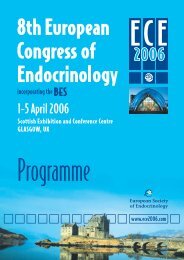
![The Endocrinologist | Issue 99 [PDF] - Society for Endocrinology](https://img.yumpu.com/48213777/1/184x260/the-endocrinologist-issue-99-pdf-society-for-endocrinology.jpg?quality=85)
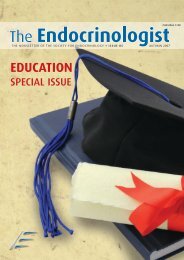
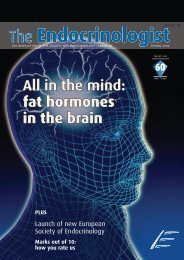
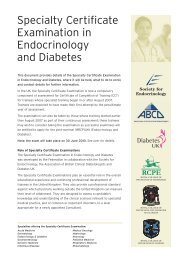
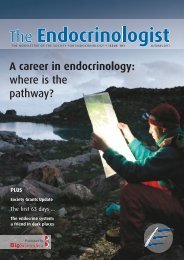
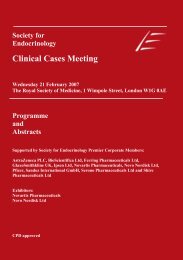
![The Endocrinologist | Issue 97 [PDF] - Society for Endocrinology](https://img.yumpu.com/40840065/1/184x260/the-endocrinologist-issue-97-pdf-society-for-endocrinology.jpg?quality=85)
